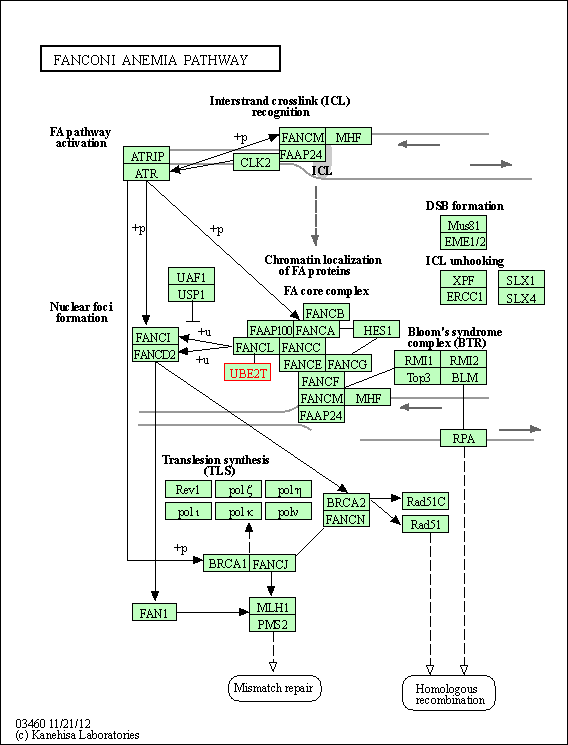Target Information
| Target General Information | Top | |||||
|---|---|---|---|---|---|---|
| Target ID |
T91451
|
|||||
| Target Name |
E2 ubiquitin-conjugating enzyme T (UBE2T)
|
|||||
| Synonyms |
Ubiquitin-protein ligase T; Ubiquitin carrier protein T; Cell proliferation-inducing gene 50 protein
Click to Show/Hide
|
|||||
| Gene Name |
UBE2T
|
|||||
| Target Type |
Clinical trial target
|
[1] | ||||
| Disease | [+] 1 Target-related Diseases | + | ||||
| 1 | Rectum cancer [ICD-11: 2B92] | |||||
| Function |
Accepts ubiquitin from the E1 complex and catalyzes its covalent attachment to other proteins. Catalyzes monoubiquitination. Involved in mitomycin-C (MMC)-induced DNA repair. Acts as a specific E2 ubiquitin-conjugating enzyme for the Fanconi anemia complex by associating with E3 ubiquitin-protein ligase FANCL and catalyzing monoubiquitination of FANCD2, a key step in the DNA damage pathway (PubMed:16916645, PubMed:17938197, PubMed:19111657, PubMed:19589784, PubMed:28437106). Also mediates monoubiquitination of FANCL and FANCI (PubMed:16916645, PubMed:17938197, PubMed:19111657, PubMed:19589784). May contribute to ubiquitination and degradation of BRCA1 (PubMed:19887602). In vitro able to promote polyubiquitination using all 7 ubiquitin Lys residues, but may prefer 'Lys-11'-, 'Lys-27'-, 'Lys-48'- and 'Lys-63'-linked polyubiquitination (PubMed:20061386).
Click to Show/Hide
|
|||||
| BioChemical Class |
Ubiquitin-conjugating enzyme family
|
|||||
| UniProt ID | ||||||
| EC Number |
EC 2.3.2.23
|
|||||
| Sequence |
MQRASRLKRELHMLATEPPPGITCWQDKDQMDDLRAQILGGANTPYEKGVFKLEVIIPER
YPFEPPQIRFLTPIYHPNIDSAGRICLDVLKLPPKGAWRPSLNIATVLTSIQLLMSEPNP DDPLMADISSEFKYNKPAFLKNARQWTEKHARQKQKADEEEMLDNLPEAGDSRVHNSTQK RKASQLVGIEKKFHPDV Click to Show/Hide
|
|||||
| 3D Structure | Click to Show 3D Structure of This Target | PDB | ||||
| Cell-based Target Expression Variations | Top | |||||
|---|---|---|---|---|---|---|
| Cell-based Target Expression Variations | ||||||
| Drug Binding Sites of Target | Top | |||||
|---|---|---|---|---|---|---|
| Ligand Name: 1,3-Benzothiazol-2-ylmethylamine | Ligand Info | |||||
| Structure Description | Ube2T in complex with fragment EM04 | PDB:5NGZ | ||||
| Method | X-ray diffraction | Resolution | 2.40 Å | Mutation | No | [4] |
| PDB Sequence |
QRASRLKREL
11 HMLATEPPPG21 ITCWQDKDQM31 DDLRAQILGG41 ANTPYEKGVF51 KLEVIIPERY 61 PFEPPQIRFL71 TPIYHPNIDS81 AGRICLDVLK91 LPPKGAWRPS101 LNIATVLTSI 111 QLLMSEPNPD121 DPLMADISSE131 FKYNKPAFLK141 NARQWTEKHA151 RQ |
|||||
|
|
||||||
| Click to View More Binding Site Information of This Target with Different Ligands | ||||||
| Different Human System Profiles of Target | Top |
|---|---|
|
Human Similarity Proteins
of target is determined by comparing the sequence similarity of all human proteins with the target based on BLAST. The similarity proteins for a target are defined as the proteins with E-value < 0.005 and outside the protein families of the target.
A target that has fewer human similarity proteins outside its family is commonly regarded to possess a greater capacity to avoid undesired interactions and thus increase the possibility of finding successful drugs
(Brief Bioinform, 21: 649-662, 2020).
Human Pathway Affiliation
of target is determined by the life-essential pathways provided on KEGG database. The target-affiliated pathways were defined based on the following two criteria (a) the pathways of the studied target should be life-essential for both healthy individuals and patients, and (b) the studied target should occupy an upstream position in the pathways and therefore had the ability to regulate biological function.
Targets involved in a fewer pathways have greater likelihood to be successfully developed, while those associated with more human pathways increase the chance of undesirable interferences with other human processes
(Pharmacol Rev, 58: 259-279, 2006).
Biological Network Descriptors
of target is determined based on a human protein-protein interactions (PPI) network consisting of 9,309 proteins and 52,713 PPIs, which were with a high confidence score of ≥ 0.95 collected from STRING database.
The network properties of targets based on protein-protein interactions (PPIs) have been widely adopted for the assessment of target’s druggability. Proteins with high node degree tend to have a high impact on network function through multiple interactions, while proteins with high betweenness centrality are regarded to be central for communication in interaction networks and regulate the flow of signaling information
(Front Pharmacol, 9, 1245, 2018;
Curr Opin Struct Biol. 44:134-142, 2017).
Human Similarity Proteins
Human Pathway Affiliation
Biological Network Descriptors
|
|
|
There is no similarity protein (E value < 0.005) for this target
|
| KEGG Pathway | Pathway ID | Affiliated Target | Pathway Map |
|---|---|---|---|
| Fanconi anemia pathway | hsa03460 | Affiliated Target |

|
| Class: Genetic Information Processing => Replication and repair | Pathway Hierarchy | ||
| Degree | 17 | Degree centrality | 1.83E-03 | Betweenness centrality | 6.67E-05 |
|---|---|---|---|---|---|
| Closeness centrality | 2.08E-01 | Radiality | 1.36E+01 | Clustering coefficient | 6.32E-01 |
| Neighborhood connectivity | 3.05E+01 | Topological coefficient | 1.49E-01 | Eccentricity | 12 |
| Download | Click to Download the Full PPI Network of This Target | ||||
| Co-Targets | Top | |||||
|---|---|---|---|---|---|---|
| Co-Targets | ||||||
| Target Affiliated Biological Pathways | Top | |||||
|---|---|---|---|---|---|---|
| KEGG Pathway | [+] 1 KEGG Pathways | + | ||||
| 1 | Fanconi anemia pathway | |||||
| References | Top | |||||
|---|---|---|---|---|---|---|
| REF 1 | UBE2T promotes nasopharyngeal carcinoma cell proliferation, invasion, and metastasis by activating the AKT/GSK3/-catenin pathway.Oncotarget. 2016 Mar 22;7(12):15161-72. | |||||
| REF 2 | URL: http://www.guidetopharmacology.org Nucleic Acids Res. 2015 Oct 12. pii: gkv1037. The IUPHAR/BPS Guide to PHARMACOLOGY in 2016: towards curated quantitative interactions between 1300 protein targets and 6000 ligands. (Ligand id: 7945). | |||||
| REF 3 | ClinicalTrials.gov (NCT01249105) MK-2206 for Recurrent Malignant Glioma. U.S. National Institutes of Health. | |||||
| REF 4 | Allosteric Targeting of the Fanconi Anemia Ubiquitin-Conjugating Enzyme Ube2T by Fragment Screening. J Med Chem. 2017 May 11;60(9):4093-4098. | |||||
If You Find Any Error in Data or Bug in Web Service, Please Kindly Report It to Dr. Zhou and Dr. Zhang.

